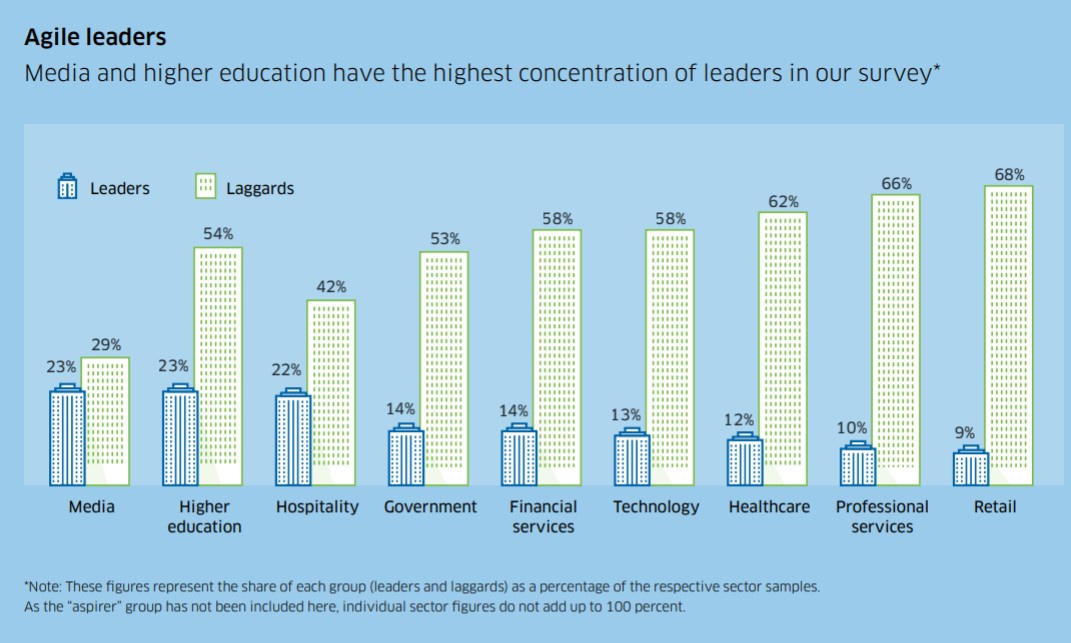Global study: How retail companies approach organisational agility
Retailers know they must stay agile and flexible to thrive now and into the future. Our global study digs into the importance of organisational agility for retailers.
Agility always pays off in the retail world, even without the effects of a global crisis, and even more so in the middle of it. The retail landscape is likely to look very different for quite a while, and staying flexible is key for retailers as the world moves forward.
Our global survey of 998 executives, “Organisational Agility at Scale: The Key to Driving Digital Growth”, shows that the majority recognise that organisational agility is key if they want to drive long-term digital growth. And, perhaps more tellingly, we found there’s a strong relationship between digital revenue growth and organisational agility.
We identified five key behaviours that are crucial to organisational agility, and then grouped survey respondents based on their level of adoption of these behaviours. Leaders (15% of respondents) achieved high performance across all five of the behaviours, while Aspirers (30% of respondents) achieved high performance in four of them, and Laggards (55%) achieved three or fewer of the behaviours.
Here are the five behaviours that are necessary for organisational agility:
- Continuous planning. They plan in a continuous, real-time manner, which gives them the speed, agility and dynamism they need to innovate successfully.
- Fluid structures and processes. Leading organisations build fluid organisational structures and processes. Nearly half claim the ability to reallocate people quickly to where their skills are needed.
- Building the future workforce. Leaders are much more likely than laggards to have plans to upskill the majority of their workforce and push specific initiatives to increase employee engagement.
- Informed and empowered decision making. At 80% of organisations that rank as leaders, all employees have access to timely and relevant data and are empowered to make appropriate decisions.
- Measurement and guidance. Leaders have made significant progress in developing tools and metrics to measure the performance of digitally driven innovations. This is giving them a “fail fast” mentality: 94% say they are able to steer away quickly from unsuccessful projects.
Our survey broke down organisational agility by industry. In the retail industry (see infographic here), 9% were identified as Leaders, 68% were identified as Laggards, and 23% were Aspirers.

Here are a few key insights from survey respondents from retail companies:
- Moving people when necessary is important but challenging. Fifty-eight per cent said they’re ready to reallocate people when their skills are needed elsewhere or new opportunities arise. This is a low number compared to other industries.
- Upskilling is gaining momentum. Seventy-two per cent said employees in their companies are encouraged to grow through upskilling.
- Customer-facing workers could use more autonomy. Only 62 per cent said their customer-facing workers can make decisions that improve the customer experience.
- Digital revenue streams may grow in importance. Our survey, conducted in late 2019, showed only 38% expect digital revenue to make up over 50% of their revenue three years from now. However, we expect that the global pandemic will accelerate a focus on digital revenues.
The challenges to organisational agility
Though many retailers are making strides toward organisational agility, they’re up against a few common challenges. When asked about moving to real-time, integrated planning, they responded that their most common obstacles are bureaucratic organisational cultures, lack of insightful data and market intelligence, and a lack of relevant employee skills.
Retailers are also working to stay ahead of changing business needs by updating processes, but report struggling with bureaucracy, inflexible legacy technologies, and a lack of motivation to move away from legacy processes.
The keys to increasing agility
Retail had the lowest percentage of Leaders of any industry in our survey, so even though the sector is changing, retailers have more work to do than most to accomplish organisational agility. But if they focus on a few key areas, they can make progress toward the ability to adapt quickly to the changing world of retail.
The ability to re-allocate employees when a need arises or when their skills are needed elsewhere is paramount, but only 58% of retailers said they can do it quickly. That lack of agility can hold the whole company back, so a focus on flexibility in that area is key.
Another area of focus revolves around this statistic: a mere 29% said their employees have full access to the data they need. When data is cordoned off from the people who need it, it’s tough to be agile.
So, to build their organisational agility muscles, retail leaders should focus on evolving their digital growth strategy, giving employees access to the data they need and being ready to re-allocate employees to where they’re needed.